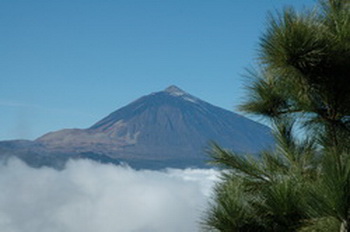
Tenerife
Canary Islands
November 2008
Part Two
| |
| HOME |
| About Tenaya |
| About Us |
| Latest Update |
| Logs from Current Year |
| Logs from Previous Years |
| Katie's View |
| Route Map |
| Links |
| Contact Us |
![]()
November 21, 2008
Tenerife is the largest of the Canary Archipelago. A chain of mountains runs east-west and creates a marked difference in the climates of the north and south of the island. The north has more rainfall, higher humidity and a temperate climate. It is ideal for cultivating fruit. Charles III of Spain established gardens here in the 18th century in attempt to acclimatize tropical plants from the New World before being shipped on the Europe. The weather in the south is dryer and warmer with pleasant sandy beaches and hi-rise apartments and hotels for the many tourists which visit year-round.
We are staying at Santa Cruz de Tenerife, a large marina in the heart of the capital in the north. With a backdrop of green mountains, Santa Cruz is pleasant with wide tree-lined streets, art deco buildings and nice walking and bike paths to the major shopping area. After staying in several resort marinas it is nice to be in a real city again.

Santa Cruz de Tenerife marina
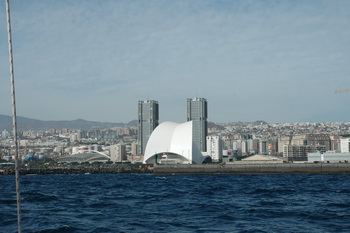
Santa Cruz as seen upon entering the harbor
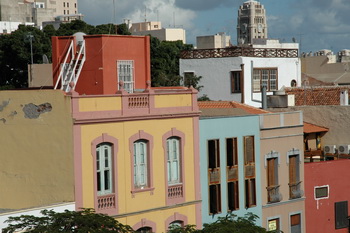
Unlike Lanzarote, Tenerife's architecture is colorful
Quite mountainous, Tenerife has the highest peak in all Spain. Pico del Teide, a gigantic volcanic cone rises to 3717 meters, just over 12,000 feet. A cable car takes visitors to within 200 meters of the often snow-capped summit.
Folded into a tiny red Fiat Panda with a 6 gallon gas tank we set out to see a bit of the island. As we headed inland we immediately began to ascend. Soon we were among thick stands of Canary Pine trees. After reaching the highpoint we drove a scenic route along the spine of the mountain chain with views to the left and right of both coasts. As we rose above the treeline we entered Parc Nacional del Teide.
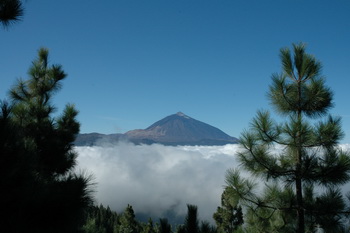
Pico del Teide rises above the clouds in a perfect volcanic cone

A large crater on the way to the summit of El Teide

Looking up towards the summit of El Teide
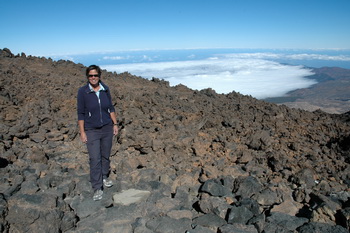
Looking down the mountain to the clouds and Atlantic
A permit acquired from Santa Cruz in advance is required to hike to the summit as the number of daily visitors is limited to 200 above the cable car. Unfortunately we did not do our research well enough and had no permits. A bad knee has harnessed my enthusiasm for steep climbs but Jim absolutely loves to reach the top of any peak. He was saddened to miss this opportunity.
.

The summit of El Teide
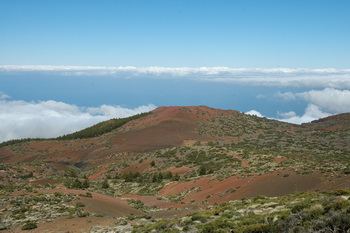
Volcanic landscape of Parc Nacional del Teide

Uplifted striated rock and sparse growth above timberline

Pumice and volcanic rock
Relaxing at a table in the warm sun we devoured our traditional meals. The chicken in typical Canarian sauce was delicious and accompanied by nearly a dozen small boiled potatoes. American portions to be sure! A couple of dogs wandered around outside waiting for the inevitable left-overs.
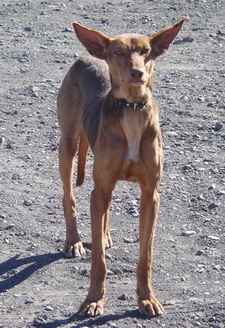
The local dogs are quite lean and have huge ears

As we descended into the clouds on the north side of the mountains the lush vegetation enveloped us. Pine trees and ferns were among the dew dampened foliage clinging to the steep slopes. Eventually we came to the island's prettiest town, La Orotava, perched above the coast. Noble 16th century mansions grace the center of a town once wealthy and prosperous and still well-to-do.
Later we passed through La Laguna, a colorful student town nearly as picturesque as La Orotava. The former island capital's full name is Muy Noble, Ilustre, Leal y Fiel Cuidad de San Cristobal de la Laguna meaning the Very Noble, Illustrious, Loyal and Faithful City of Saint Christopher of the Lagoon. Whew. A short while later we were back in Santa Cruz.
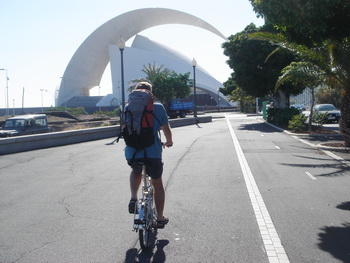
Jim cycles past Santa Cruz's distinctive auditorium on the way to Carrefour
Although Tenaya has enough food to last months without reprovisioning, we couldn't pass up the chance to buy a few more things from the huge Carrefour, well-stocked Mercadona, El Corte Ingles department store and the largest market in the Canaries.
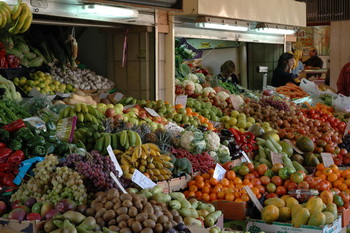
One of the many stalls in the market at Santa Cruz
In a day or two we will sail overnight to the northwestern most island of the archipelago, La Palma. We plan to stay at Santa Cruz de La Palma, a new marina in the town of Santa Cruz. A bit confusing, it has the same name as where we are now. I'll have to research why, of all the saints, Santa Cruz figures so prominently in the Canaries.
Go to November 2008, Part Three
.